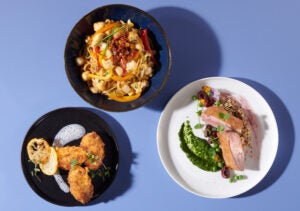Combining SKUs can save money on your bid and make your menu and your kitchen more efficient
Maximizing efficiency is critical in healthcare, especially in foodservice, where every dollar has to stretch as far as possible. Some pressure points are beyond the foodservice director’s control—the size of your annual budget, labour and food-cost changes as well as regulatory shifts. That makes it essential to focus on areas you can control, such as buying practices.
When placing your bid for food purchases, it’s the ideal time to examine your stock-keeping units (SKUs) and consider ways to combine items and optimize your bid. Group-purchasing organization (GPO) representatives and healthcare foodservice directors have a number of money-saving procurement ideas. Your Gordon Food Service Sales Representative also is prepared to suggest ideas that reduce ordering costs and provide efficiencies with food storage, menu preparation and waste reduction. Here are four points to consider:
Take a gradual approach
There’s a big difference between having a hunting list with thousands of items and a specific shopping list that meets compliance and menu needs, says Kevin Crampton. He’s the Vice President of Business Development and Contracting at HPS, a Michigan-based, member-owned GPO that serves more than 3,000 organizations.
“Having fewer SKUs means you increase the potential to order one item in bigger volume, making it cheaper,” he says. “It helps the distributor with their planning, costing, storage and other behind-the-scenes factors that save the buyer money.”
Just don’t be too quick to combine everything. Crampton suggests going from at least three SKUs to one is the sweet spot for achieving value.
With thousands of different food items to consider, it also pays to be careful which SKUs to combine. High-volume items should get first consideration. If a distributor is holding a slot for a low-volume item, then storage cost and liquidation costs affect large-volume items.
Focus on simplicity
Peter Mueller, Food and Nutrition Manager for Millennium Trail Manor in Niagara Falls, Ontario, notes that fewer SKUs means fewer items to track and fewer variables in the preparation and serving process.
He oversees the menu for the eight communities that are part of the Conmed Health Care Group, so he knows firsthand the value of consolidating product purchases. Each of his kitchens is on a three or four-week cycle, with menus that change for the spring/summer and fall-winter seasons based on food availability and seasonal meal preferences.
“With a standardized menu, I can create a shopping list that covers what we plan to menu for the week,” Mueller says. “It helps me keep things consistent and keep things moving in and out of my inventory.”
His stock room inventory maintains a just-in-time approach. While keeping a 72-hour food supply on hand in accordance with the Long Term Care Homes Act requirements, Mueller says he keeps two cases of key products on hand at any given time, where possible. This makes sure he has just the amount he needs, while maintaining room for new items as they come in. This small-scale, first-in, first-out approach saves money by preventing spoilage and waste, plus it saves labour hours tracking inventory and deters theft.
Using the same products saves money on ordering, delivery, storage and in the kitchen. When every community is using the same products, it regulates preparation and serving practices, plus it cuts down on mistakes.
“I receive a regular velocity report so I know what’s being purchased and I can compare it to what’s being used in the menu to find ways we can be more efficient,” he notes.
Think in terms of cross-utilization
For Mueller, reducing SKUs and cross-utilizing foods are great ways to control costs.
“I look for products I can use in multiple ways,” Mueller says. “It makes it easier on my staff to prepare if I utilize same beef product in multiple recipes, such as pot pies, stir-fry, stew, goulash, etc.”
The cycle menu makes it easier promote cross-utilization. Cycle menus tell the kitchen manager exactly how much to order, how to include the food items in each dish and how many servings each dish will provide.
Resist the urge to play favorites
The menu can be a delicate subject. Data—whether it’s tracking meals served or the amount of food that goes uneaten—will show which foods are most popular. It’s tempting to revamp the menu to offer more choices or to purchase a special ingredient to spruce up a single dish. That’s a place where paying attention to what you order can pay off.
Why order a case of cilantro when you only need to use it in a cilantro-lime rice dish once a week? That can be costly in both obvious and hidden ways. Yes, it creates waste if you don’t need that much cilantro, but it also takes up extra storage room in your cooler and it requires a foodservice distributor to devote costly warehouse space. The same costs apply to more popular menu items, such as chicken. Instead of placing orders for dozens of chicken SKUs throughout the organization, it’s beneficial to agree on as many common items as possible to get the most out of your contract.
“I look at the items we all commonly order and try to find ways to make sure we’re all using the same products and then negotiate a contract,” Mueller explains. “A good example is coffee. There are lots of suppliers and choices out there, so I look for ways to bring it all under one umbrella.”
Another benefit is forming a relationship with a single supplier, which can include perks such as support equipment or even sponsored participation at an event.
While having a contract with a single supplier might mean giving up a certain brand-name product, there are benefits that extend to the GPO as well.
“If we have a contract with one manufacturer, they get good data for forecasting and customers get a good price because there is a lot of business to be won,” Crampton says. “At the same time, kitchen managers can count on inventory management and consistent flavor profiles for the foods they buy.”

























